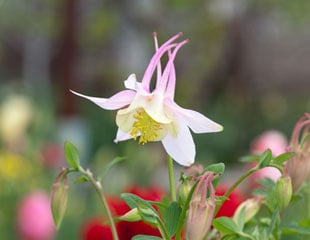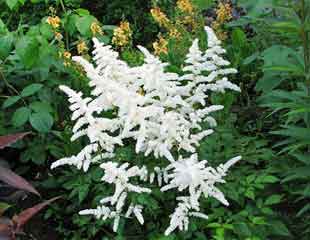


10 of the Best Easy to grow flowering plants
Plants which are easy to grow and foolproof, are a joy. Not everyone wants to, or has the time to spend toiling away in the garden. Sometimes it is nice to sit, unwind after a hard day and enjoy the garden. Many of us have busy lives, children to look after, parents to care for, demanding jobs and careers to pursue.
The Sunday Gardener looks at plants which are genuinely easy to grow and need little or no maintenance.
Pick and mix from these plants for all year round colour and interest without staking, pruning and feeding.
The plants on these pages are reliable, and will grow well anywhere in the country and in most conditions. They are fully hardy and low maintenance.
Notice there are no climbing plants, even the easy ones such as passionflower, and winter flowering Jasmine needs some maintenance and many climbing plants, such as Clematis, are high maintenance.
I hope you enjoy this selection of easy plants, leaving you with more time to enjoy the garden.

Plants listed on this page are designated "Green Wheelbarrow" which means they are easy to grow, tolerant of most growing conditions and, once planted, need little attention.
More about the Sunday Gardener's Colour Coding
Hardy Geranium, common name Cranesbill

Widely grown by gardeners, the hardy geranium is a reliable summer flower plant attractive to bees ( check out this short video Bees love blue) and long flowering. I have seen Geraniums in flower right through to late October. Regular dead heading will prolong flowering, but this can be time-consuming and is not essential.
To avoid the maintenance of dead heading just sheer it down in June/July after the first flush, and it will re grow foliage, and sometimes, depending on the variety, more flowers. There are many types of Geraniums to choose from and all are easy to grow. This type of Geranium varies in size, the largest around 60 cms ( 2 foot) to quite small creepers of just a few centimetres tall.
Aubretia

Understated Aubretia is easy and makes an impressive show of colour trailing down a wall. Aubretia is a perennial which flowers reliably every April/May and requires no attention other than cutting back after flowering.If you neglect to do so, it will still perform although eventually you will have to take the sheers to it.
Sedums

Sedum is a breeze to grow and such a tidy plant. Older versions tended to flop outwards, leaving the middle of the plant bare, but newer cultivars stand upright and are a butterfly and pollinator magnet. They are easy to grow and only need cutting down in the spring to make way for the new growth. Popular varieties are in various shades of red and pink. There are also varieties with purple leaves and low growing types flowering white and yellow, ideal for growing in crevices and pavings.
Allium so easy to grow



Alliums are easy to grow and mix so well with many popular garden plants. Here they are growing with the grasses, deschampsia and the late flowering allium sphaerocephalon. Spring /summer flowering Alliums look good planted in large groups, with the sharp green of Alchemilla mollis - Lady's Mantle, (also easy to grow, too easy can be invasive,) and hardy geranium. There are lots of Alliums to choose from. The shorter varieties do not require staking. Planting and Growing advice for Alliums.
Aquilegia

Aquilegia is a lovely spring flower, easy to grow, and a wide range of colours to choose from. Aquilegia needs no attention to reappear each year. It is a perennial with dainty flowers. Aquilegia self seeds, but it is not too invasive.
Grow Aquilegia for early spring colour or an easy to maintain combination, is Aquilegia 'Swan Lavender' with the evergreen Euonymus, combined with a lovely yellow deciduous scented Rhododendron luteum. Information on How to grow Aquilegia.
Hellebores

Hellebores are clump forming perennials which flower over winter and early spring. They are easy to establish and, as a woodland plant, are happy in dappled shade and will self seed around to form clumps.
Hellebores flower in shades of pink, maroon, white, cream and green and have single or double flowers with speckled flowers.
They flower for a long time, have attractive flower heads as they fade and make an interesting cut flower. Tips on growing Hellebores.
Lavender and Nepeta


In some ways, these plants are interchangeable. Lavender, if you have good dry sunny conditions and well-drained soil, is very easy to grow, and is correctly listed as one of the easiest flowering plants. For all those gardeners who have wet, heavy soil, with lots of winter wet, Lavender will struggle, but tough grow anywhere Nepeta, is a good substitute.
So if you are looking for an easy blue theme for your borders, try Lavender or Nepeta
Daffodils Narcissus

It is easy to overlook Daffodils, but of all the spring bulbs, daffodils are easy to grow. Once planted to the right depth, they can be left alone to get on with the job of flowering each year.
You can feed bulbs after flowering, but equally if you don't, they will still flower and many Narcissus have the bonus of being scented. They will tolerate a wide range of conditions and return reliably each year..
Allium purple sensation combined with Euphorbia palustris

Alliums are bulb, and a great garden favourite; they will pop up each year with no fuss. There are spring and summer flowering Alliums, illustrated is a spring flowering bulb combined with Euphorbia which hides the less attractive base foliage of the Allium.
Euphorbias palustris will grow itself and has attractive, bright lime green foliage.
Summer flowering Alliums also look good with grasses and Achillea, see below.
Stipa tenuissima

Many of the grasses are easy to grow and give a contemporary feel to the border.
The popularity of grasses has left upwards in the last few years and the garden centres often have on offer some fabulous looking grasses, but not always hardy. An important point when selecting a grass if you are looking for easy to grow and low maintenance, is to pick a fully hardy grass such as Deschampsia, Stipa tenuissima, Molinia caerulea, Panicum virgatum, none of which are thugs and all are hardy.
A little maintenance is required in cutting back in the spring, if the plant looks tatty
Astilbe

Astilbe asks nothing of the gardener except to be planted in a spot on the shady side. Given these conditions, Astilbe is a herbaceous perennial which will return reliably every year and looks ideal with ferns in a shady corner.
Astilbe has lovely soft plumes of flower in reds, mauves, pinks and creamy white. Astilbe is easy to grow and definitely a green wheelbarrow plant.
